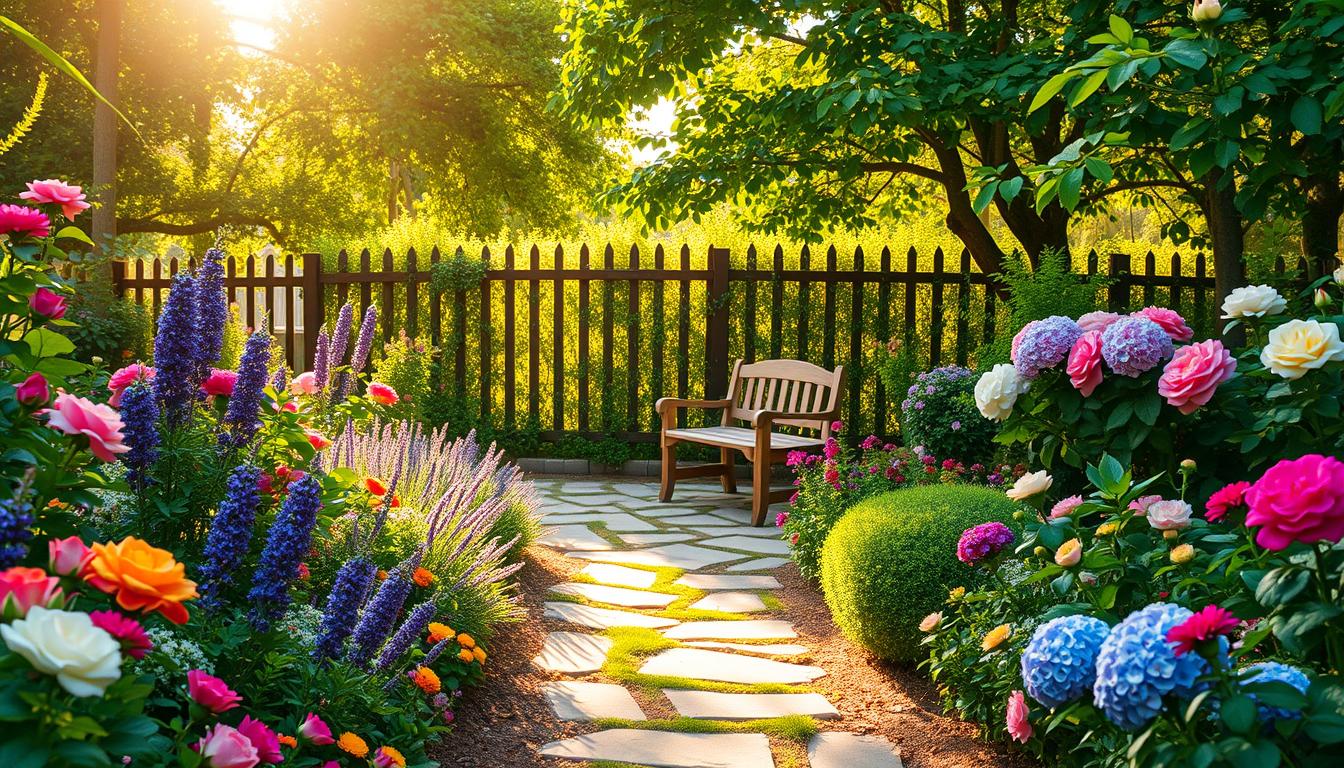Creating a stunning outdoor space is about blending beauty and practicality. Whether you’re working with a small area or a sprawling lawn, the right design can transform your surroundings. One growing trend is combining ornamental and edible elements, making your space both attractive and functional.
Native plants are a fantastic choice for any outdoor area. They thrive in local climates and support pollinators like bees and butterflies. According to Minnesota Extension, these plants require less maintenance and help sustain the ecosystem. Adding them to your design can make a big difference.
Your outdoor space should reflect your home’s style, whether it’s Craftsman, Colonial, or Contemporary. Matching the design to your architecture ensures a cohesive look. This approach also considers your maintenance capabilities, so you can enjoy your space without stress.
In this article, we’ll explore design principles, plant selection, and seasonal care tips. You’ll also learn how to solve common challenges, ensuring your outdoor area remains beautiful year-round.
Key Takeaways
- Blend ornamental and edible elements for a functional and attractive space.
- Native plants support local ecosystems and require less maintenance.
- Match your outdoor design to your home’s architectural style.
- Consider maintenance needs when planning your space.
- Explore design principles and seasonal care for long-term beauty.
Introduction to Yard Gardens
Modern outdoor spaces are evolving into eco-friendly havens. Gone are the days when these areas were purely ornamental. Today, they serve as multi-functional spaces that combine beauty with ecological benefits.
One significant shift is the move toward eco-conscious designs. Native plants are now a popular choice, as they support pollinators like bees and butterflies. The University of Minnesota Extension’s “Plants for Pollinators” initiative has been a game-changer, promoting sustainable practices like bee lawns.
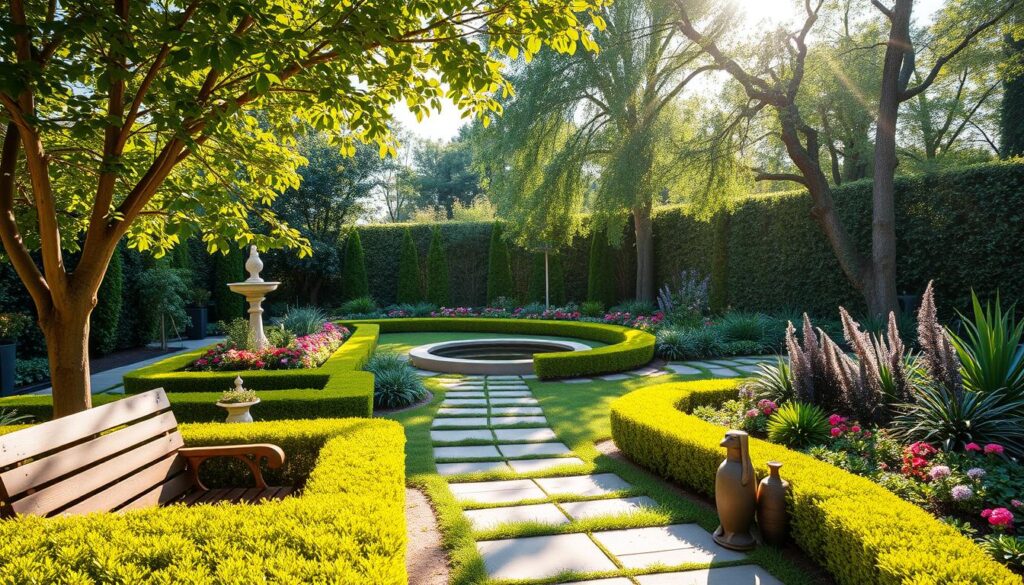
Master Gardener Larry Enfield is a great example of community impact. He donated 600 plants to local projects, enhancing neighborhood connections. A Palo Alto case study found that front yard gardens increased social interactions by 40%.
Proper soil management is the foundation of any successful outdoor space. Techniques like the lasagna method, which layers organic materials, can improve soil health. This ensures your plants thrive with minimal effort.
Another innovative concept is the use of mixed borders. These combine evergreens with seasonal blooms, creating year-round visual interest. This approach not only enhances the landscape but also supports biodiversity.
| Element | Benefit |
|---|---|
| Native Plants | Support pollinators, require less maintenance |
| Bee Lawns | Promote biodiversity, sustainable landscaping |
| Mixed Borders | Year-round beauty, supports local wildlife |
For beginners, starting with these principles can make a big difference. If you’re new to gardening, check out this guide on how to start a garden in 8 simple. It’s a great resource to get you started on the right foot.
Designing Your Yard Garden
A well-thought-out layout can transform any space into a cohesive and inviting environment. Whether you prefer formal symmetry or the relaxed charm of a cottage-style design, the right structure sets the tone for your entire area.
Choosing the Right Layout
Your layout choice depends on your personal style and the architecture of your home. Formal designs often feature straight paths and symmetrical beds, while informal layouts use curved beds and meandering paths for a natural look. For example, a Colonial-style home pairs well with brick bands and straight lines, while a Bungalow benefits from tumbled bluestone paths.
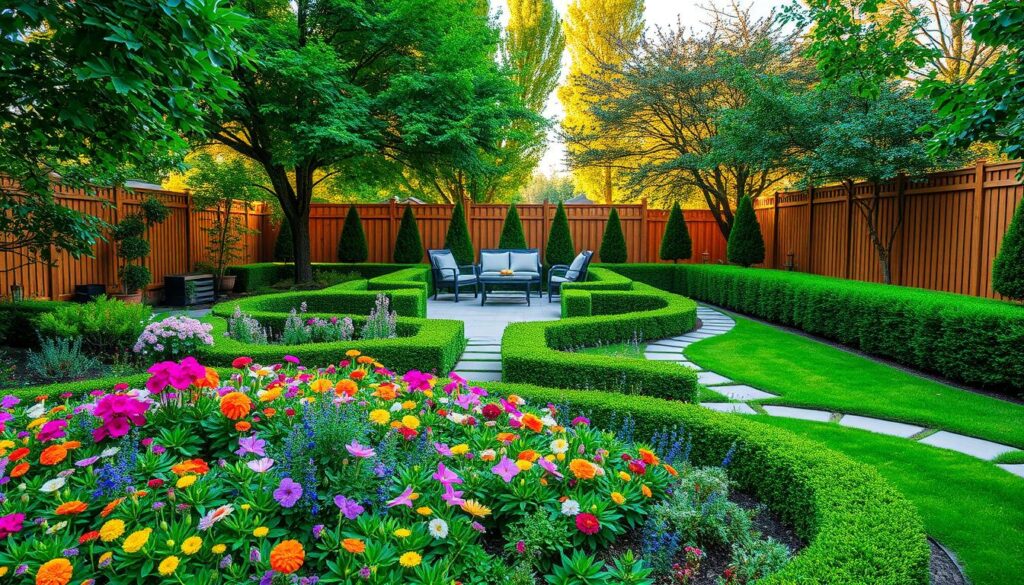
Incorporating Hardscaping Elements
Hardscaping adds both beauty and functionality to your space. Materials like brick and stone not only match your home’s architecture but can also increase property value by 15%. Consider using bluestone edging for a polished look or poured concrete for durability. Retaining walls and terracing are excellent solutions for sloped areas, ensuring stability and visual appeal.
Creating Focal Points
Focal points draw the eye and add interest to your design. Arbors, especially those covered with climbing roses, make stunning entrances. Structural plants like Japanese barberry and coral bells provide year-round beauty, even in winter. These elements create a sense of balance and highlight the best features of your space.
- Analyze layout options: formal symmetry vs. cottage garden informality.
- Use hardscaping materials like brick and stone to enhance your design.
- Add focal points such as arbors or structural plants for visual interest.
- Address slope challenges with retaining walls or terracing.
Selecting the Best Plants for Your Yard Garden
Choosing the right plants can elevate your outdoor area into a vibrant, thriving space. Whether you’re drawn to colorful flowers, practical herbs, or hardy shrubs, your selections will shape the look and feel of your surroundings. Let’s explore the best options to create a balanced and sustainable design.
Annuals vs. Perennials
Annuals, like marigolds and petunias, bloom for one season, offering vibrant colors and flexibility. They’re perfect for adding quick pops of color to your space. Perennials, such as coneflowers and daylilies, return year after year, providing long-term beauty and reducing replanting efforts.
Consider combining both for a dynamic display. Annuals can fill gaps while perennials establish themselves. This approach ensures your outdoor area remains lively throughout the year.
Native Plants and Their Benefits
Native plants, like purple prairie clover and butterfly weed, are ideal for supporting local ecosystems. They thrive in their natural climate, require less water, and attract pollinators like bees and butterflies. According to Minnesota Extension, these plants are also more resistant to pests and diseases.
Incorporating native species not only enhances biodiversity but also reduces maintenance. They’re a smart choice for eco-conscious designs.
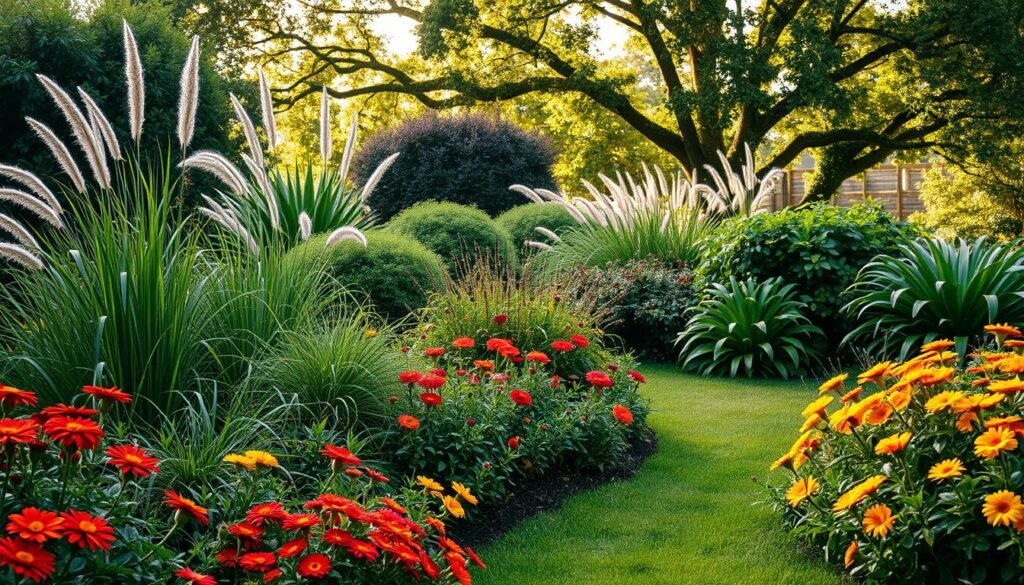
Vegetable and Herb Gardens
Edible plants like tomatoes, basil, and rosemary add both beauty and functionality. Companion planting, inspired by Colonial herb gardens, can improve growth and deter pests. For example, planting basil near tomatoes enhances flavor and repels insects.
Container gardening is another great option, especially for herbs like lemon thyme or mint. It’s perfect for small spaces and adds a touch of greenery to patios or balconies.
| Plant Type | Benefits |
|---|---|
| Annuals | Quick color, seasonal flexibility |
| Perennials | Long-term beauty, low maintenance |
| Native Plants | Supports pollinators, eco-friendly |
| Vegetables & Herbs | Functional, enhances biodiversity |
By carefully selecting your plants, you can create a space that’s both beautiful and sustainable. Whether you prefer colorful flowers, practical herbs, or native species, the right choices will transform your outdoor area into a thriving haven.
Seasonal Care for Your Yard Garden
Seasonal changes bring unique challenges and opportunities for your outdoor area. Adapting your care routine to the time of year ensures your plants thrive and your space remains inviting. From spring blooms to winter frost, each season demands specific attention.
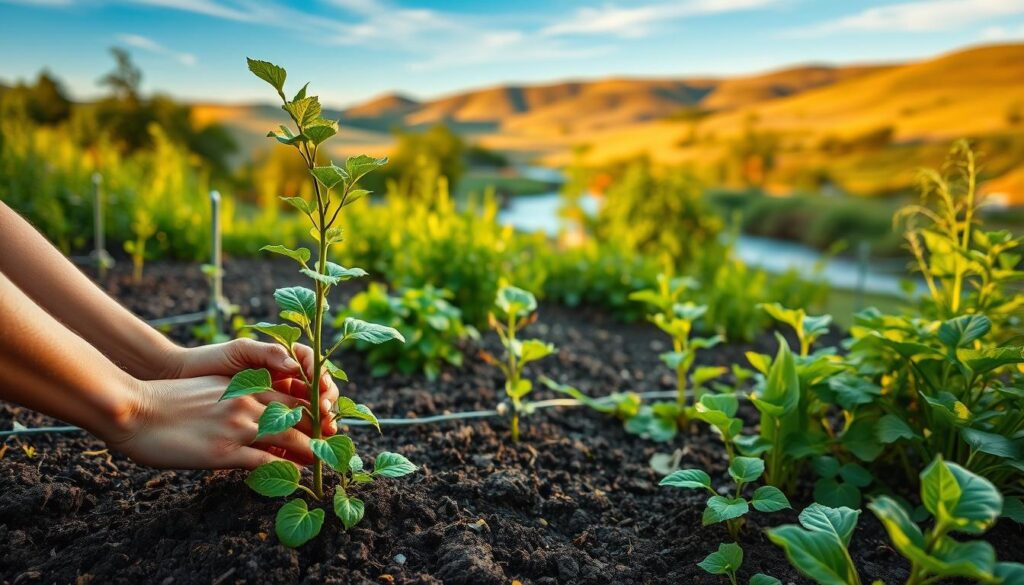
Spring and Summer Maintenance
Spring is the perfect time to prepare your space for the growing season. Start by amending the soil with compost or organic matter to improve its quality. Divide perennials to encourage healthy growth and plant cool-weather crops like lettuce and spinach.
As summer arrives, focus on proper watering techniques. Aim for deep, infrequent watering to encourage strong root systems. Deadhead flowers to promote continuous blooms and monitor for pests like aphids or spider mites. Regular maintenance keeps your space vibrant and healthy.
Preparing for Fall and Winter
Fall is the ideal time to plant bulbs for spring blooms. Prune roses and other shrubs to encourage healthy growth next year. Manage fallen leaves by composting or using them as natural mulch to protect plants during colder months.
Winter requires protective measures to shield your space from harsh weather. Apply a thick layer of mulch around the base of plants to insulate roots. Use burlap or other materials to shield evergreens from frost damage. Proper care ensures your outdoor area survives the winter and thrives in the next season.
- Spring checklist: Soil amendment, dividing perennials, planting cool-weather crops.
- Summer tasks: Deep watering, deadheading flowers, pest monitoring.
- Fall preparation: Bulb planting, rose pruning, leaf management.
- Winter protection: Mulching techniques, shielding evergreens.
Watering and Soil Management
Healthy plants start with the right balance of water and soil. Proper techniques ensure your plants thrive while conserving resources. Whether you’re a beginner or an experienced gardener, mastering these basics can make a significant difference.
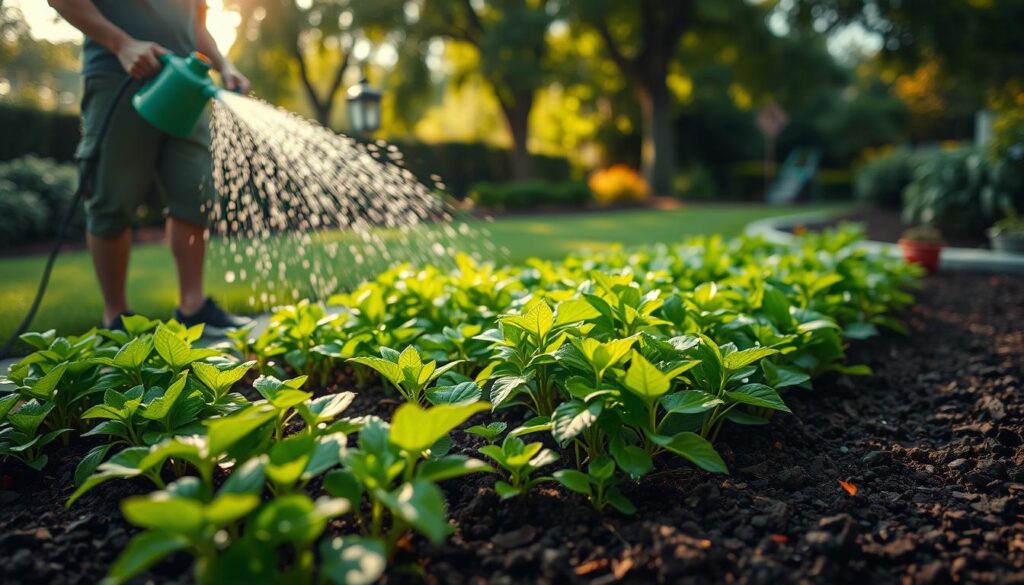
Efficient Watering Techniques
Using the right watering methods can save time and resources. Drip irrigation and soaker hoses are excellent options. Drip systems deliver water directly to the roots, reducing evaporation. Soaker hoses are ideal for larger beds, providing even moisture distribution.
Rainwater harvesting is another eco-friendly solution. Collecting rainwater in barrels ensures a sustainable water source for your plants. This method also reduces reliance on municipal supplies, making it a win-win for your space and the environment.
Improving Soil Quality
Healthy soil is the foundation of a thriving outdoor area. Start by testing your soil to understand its composition. The Minnesota Extension’s soil test protocol provides results in just two weeks, helping you identify deficiencies.
Amend your soil with organic materials like compost or vermicompost. These additions enrich the soil with essential nutrients, promoting robust plant growth. The lasagna gardening method, which layers organic materials, can improve soil health over four months.
For areas with poor drainage, raised beds are a practical solution. They allow better control over soil quality and prevent waterlogging. Proper tilling, at a depth of 6-8 inches, ensures optimal root growth and nutrient absorption.
Mulching is another key practice. Options like bark chips or straw help retain moisture, regulate temperature, and suppress weeds. Choose the right mulch for your beds to maximize its benefits.
| Technique | Benefit |
|---|---|
| Drip Irrigation | Efficient water delivery, reduces evaporation |
| Rainwater Harvesting | Sustainable water source, eco-friendly |
| Soil Amendments | Enriches soil with nutrients, improves structure |
| Raised Beds | Improves drainage, better soil control |
| Mulching | Retains moisture, regulates temperature |
“The health of your plants is directly tied to the quality of your soil and the efficiency of your watering methods.”
Dealing with Common Garden Problems
Keeping your plants thriving means tackling pests, diseases, and weeds head-on. These challenges can disrupt the beauty and health of your space, but with the right strategies, you can maintain a vibrant and thriving area.

Pest and Disease Control
Common insects like Japanese beetles and squash bugs can wreak havoc on your plants. The Minnesota Extension’s IPM program highlights the success of organic solutions like neem oil and diatomaceous earth. These methods effectively control pests without harming beneficial insects.
Companion planting is another powerful tool. For example, planting marigolds near tomatoes can reduce aphid infestations by up to 60%. This natural approach not only deters pests but also enhances plant health.
To prevent diseases, practice crop rotation in vegetable areas. This disrupts the life cycle of pathogens, keeping your plants healthy. Regularly inspect your plants for early signs of trouble, such as discolored leaves or unusual spots.
Weed Management Strategies
Weeds compete with your plants for nutrients and water, making control essential. Timing is critical when using pre-emergent herbicides for crabgrass. Apply them early in the season to stop weeds before they take root.
For persistent weeds, try sheet mulching. This technique involves layering cardboard and mulch to smother weeds naturally. It’s an eco-friendly solution that also improves soil health over time.
Creating habitats for beneficial insects, like lacewings and bees, can also help. Install lacewing hotels or bee blocks to attract these allies, which naturally keep pests in check.
- Identify common pests: Japanese beetles, squash bugs.
- Use organic solutions: neem oil, diatomaceous earth.
- Prevent diseases through crop rotation.
- Apply pre-emergent herbicides for crabgrass.
- Try sheet mulching for persistent weeds.
- Build habitats for beneficial insects.
Enhancing Your Yard Garden with Accessories
Accessories can transform your outdoor area into a personalized retreat. From functional furniture to eye-catching decor, the right touches add both style and practicality. Whether you’re creating a cozy nook or a vibrant gathering spot, these elements bring your vision to life.
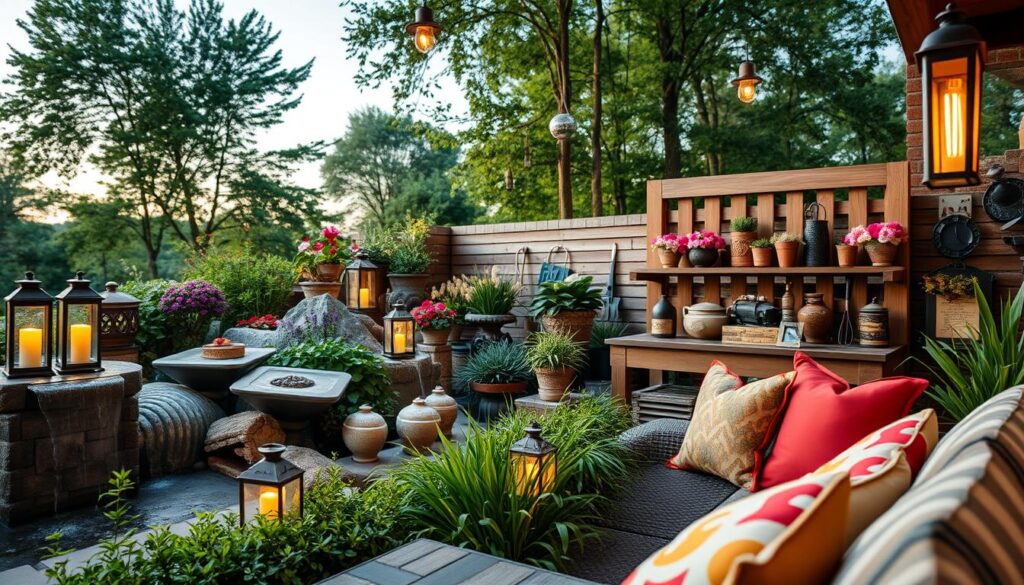
Choosing the Right Furniture and Decor
Selecting weather-resistant materials ensures your furniture lasts for years. Teak benches and powder-coated steel tables are durable and stylish options. For a touch of personality, consider DIY projects like mosaic stepping stones or repurposed container planters.
Incorporate sound elements to enhance the ambiance. Bamboo wind chimes or bubbling fountains add a soothing touch. Seasonal transitions, like autumn wreaths or holiday lights, keep your space fresh and inviting throughout the year.
Lighting and Water Features
Proper lighting extends the usability of your space into the evening. Colonial-style arbor lighting not only illuminates but also adds a charming structure. Path markers and uplighting for trees ensure safety while highlighting focal points.
Water features, like fountains or bird baths, bring life and movement to your area. Heated baths and native berry shrubs attract birds, adding a lively touch. Palo Alto’s multi-functional bluestone edging and path combo is a great example of blending practicality with beauty.
- Opt for weather-resistant materials like teak or powder-coated steel.
- Add sound elements with bamboo wind chimes or fountains.
- Use lighting to enhance safety and highlight key areas.
- Incorporate water features for a dynamic and inviting space.
- Transition decor seasonally for year-round appeal.
“The right accessories turn an ordinary space into a personalized retreat, blending beauty and functionality seamlessly.”
Conclusion
Transforming your outdoor area into a thriving haven starts with thoughtful planning. A well-designed garden not only enhances your home’s appeal but also supports local ecosystems. Whether you start small with herb patches or dive into pollinator-friendly designs, every effort counts.
For ongoing learning, consider joining Master Gardener programs. These resources provide valuable insights into care techniques and adapting to changing climate conditions. Plus, a curated landscape can boost property value by 15-20%, making it a worthwhile investment.
Take the first step by testing your soil and participating in community plant swaps. With the right structure and seasonal adjustments, your space can flourish year-round. Let your garden reflect your passion and commitment to a greener future.

